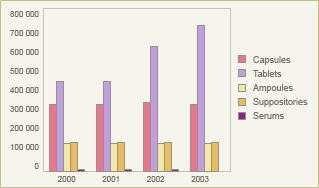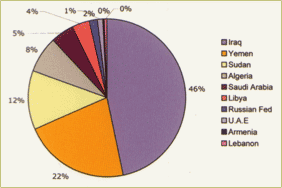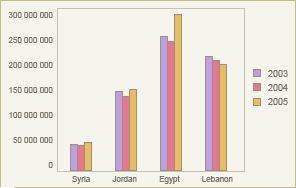|
Over View
Pharmaceutical in Syria:
The
Pharmaceutical industry is
relatively young in Syria .only 15
years ago Syria had to import over
82 percent of its drug needs and
there were only two state-owned
factories supplying the country
.however , since that period tens of
companies have been established and
local production is estimated to
cover around 90 percent of demand
.Capacity is estimated to be twice
market demand which in turn is
estimated at around USD 300 million
per year . Exports of
pharmaceuticals represent only a
negligible share of total exports
although they have grown
exponentially in the last three
years . |
| |
|
Syria's Key Industrial (2004)
Population (million) : 17.8
Area (sq km): 185.180
GDP (USD, billion) : 23.1
Per capita GDP (USD) : 1.300
GDP growth (%) : 3.6
Exports (FOB , USD million) : 4.823
Imports (CIF, USD million) : 5.177
Current account balance (USD
million) : 514
Unemployment rate (%) : 16
Human Development Index : 0.721
Literacy rate (%) : 83
Currency : Syrian Pound (EUR1= SYP
63.25 on 18/04/2006)
Capital : Damascus
Official Language : Arabic
|
| |
|
Industry Structure
Inputs :
Syria produces only little active
material and 85 percent of total
input value is estimated to be of
foreign content. While the import of
drugs that are manufactured in Syria
is banned , items not produced in
the country can be brought in . the
main import items are serums ,
vaccines , cancer treatment
medicines , insulin , etc .
Saydalaya , a state-owned
organization , has the monopoly of
imports of manufactured drugs
although the Government is expected
to open this market to the private
sector . there is almost no research
and development due to the lack of
patent protection .
Control
and regulatory authority :
Strict control is exercised by the
ministry of Health (MOH) over the
industry . the MOH which established
a Good Manufacturing Practice
guideline in conjunction with the
World Health Organization , enforces
strong quality controls and has the
capacity to close outright any plant
that does not abide by its standards
. the MOH also sets the price of any
drug that is produced and sold in
Syria with the aim of making
medicines available to all segments
of society .
Production:
There are 52 firms producing
pharmaceutical products . Syria has
the largest number of pharmaceutical
companies compared with any other
Arab market , even though its
domestic market size is smaller than
many others . Private capital
inflows have increased significantly
in the last decade thanks to the
involvement of several major
industrial and trading groups in the
drug industry . the two largest
cities in the country , Aleppo and
Damascus host the largest industrial
firms . Alpha , Assia, Oubari and
Amrit are among the leading firms
based in Aleppo , while MPI ,
Avenzor , Thameco and Unipharma are
located in the Syrian capital .
Businesses operating in the industry
can be divided in three large
groups : (1) 8 or 9 large firms
that have adopted modern production
and marketing techniques and produce
both their own generic products as
well as licensed ones . these
companies have a broad range of
products and are starting to export
. Among them is Thameco , one of the
two state-owned . Companies active
in the industry (2) around 25
midsized companies producing mainly
generic products and selling to the
domestic market with only limited
exports ; (3) around 25 smaller
companies that have limited product
ranges and often operate
intermittently .
Distribution :
The estimated size of the Syrian
pharmaceutical market is between USD
250 and 350 million at wholesale
prices . local manufactures ,
including the two state owned plants
, cover around 90 percent of market
demand while imports , making up the
balance , stand at between USD 30
and 50 million according to official
statistics . Distribution is via
8.000 pharmacies spread throughout
the country . on average there are
around 2.125 inhabitants per
pharmacy . the MoH sets prices
according to a formula that includes
all production and marketing costs ,
plus a 20 percent profit margin for
the manufacturer . Prices of
Licensed products are usually set at
around a 50 percent premium .
foreign firms can not open
subsidiaries but are allowed to open
"scientific offices " which can
conduct marketing activities for
their products , whether they are
imported or produces under license .
the strong price controls exercised
by the Ministry have two negative
consequences : one of these is
psychological as many patients are
often reluctant to buy cheap
medicines that they associate with
poor quality ; the other is that the
downward pressure on prices is
forcing some manufacturers to limit
costs and research and development .
Exports:
Syrian firms lack experience in
international trading and marketing
and the relatively small size of
most firms operating in the industry
does not help to improve matters .
the sector as a whole lacks any
joint marketing efforts or a trade
association however , the Syrian
European Business Centre has
provided support to boost exports .
A key issue for access to world
markets is the absence of patents
and the difficulty in implementing
and enforcing intellectual property
rights in Syria .
|
| |
|
Production
Syrian official statistics only
provide production figures on the
basis of presentation formats . the
data available show a significant
surge in production volumes . no
figures on the value of production
are available . however , strict
controls by the MoH on prices in the
domestic market ensure that unit
values remain relatively low . |
 |
|
|
Production of Pharmaceuticals ('000) |
| |
|
Export \ Import
According to official statistics ,
Syria exports only to ten countries
, eight of them being in the Arab
World , the others being Russia and
Armenia .Iraq alone is the
destination of almost half of the
country's exports .88 percent of
drug exports go to the top four
destination markets , which are all
in the Arab world . there is a
contradiction between theses figures
and those of the Department of Trade
of the European Commission , which
reports that Syrian exports to the
EU reached EUR 1.5 million in 2004
Although at a low level , exports
have surged in the last few years
in the period 2001-2004 they
increased 18 times .
According to official Syrian
statistics , total imports of
Pharmaceutical products were between
USD 40 and 43 million in 2004 ,
depending on the basis of
calculation . Antibiotics alone
represent over half this figure . in
terms of countries of origin , Syria
has a very diversified import base .
the European Union , India and the
United States of America are among
the country's main suppliers . the
top ten supply 80 percent of all
drugs imported into Syria . Syrian
statistics do not match with the
EU's figures. According to DG Trade
of the European Commission , the EU
exported 52 million euros worth of
drugs to Syria in 2004 , roughly
twice as high as the Syrian figure
|
 |
|
Exports by Destination (2004) |
|
 |
 |
|
Comparative
Exports to EU ( € ) |
Comparative Imports to EU ( € ) |
| |
|
Quality & Technical Standards
The standards for the production of
Pharmaceuticals must meet the
criteria of Good Manufacturing
Practice of the Ministry of Health
that were developed with the World
Health Organization . |
| |
|
References and Publications
:: Pharma Syria 2006 , the
Syria Report , 2006
:: The Statistical Abstract ,
Central Bureau of Statistics ,
2004&2005.
:: Summery of Foreign Trade
2005 , Central Bureau of Statistics
, 2005 .
:: Profile of the Syrian
Pharmaceutical Sector , SEBC , 2003
.
:: The Impact of the Euro-Med
Association Agreement on the Syrian
Pharmaceutical Sector , SEBC , 2003
:: The Syrian Pharmaceutical
Market (in French) , French Trade
Mission , Damascus , 2003
:: The Distribution of
Pharmaceuticals in Syria (in French)
, Letter de Syria , French Trade
Mission , Damascus, September
::
2005 .
:: Market Access Database , DG
Trade , European Commission :
http://mkaccdb.eu.int
|
| |
|